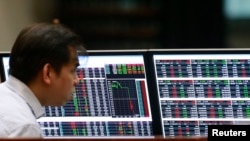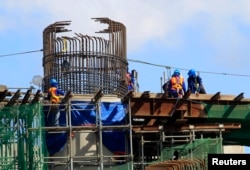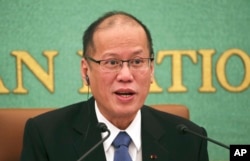When Filipinos head to the polls in May to pick a new president, foreign business leaders in the country say they will be watching with keen interest.
Members of the Joint Foreign Chambers of the Philippines expressed concern that nagging issues that have kept more multinationals from entering the country may not be immediately addressed.
On Tuesday, the Chambers heard from representatives of the top five presidential candidates, who were invited to present what the group called “bold ideas” for the next decade. In the Philippines, presidential terms last six years and leaders are limited to one term.
The business leaders are looking for solutions that they said would help create jobs, alleviate poverty and make the Philippines more globally competitive.
The Joint Foreign Chambers have long contended the country’s laws have hindered foreign direct investment, placing the Philippines far behind other countries in Southeast Asia that have similar economies.
Canadian Chamber President Julian Payne said he “was not satisfied” with some answers regarding easing certain restrictions.
“Those issues on the ‘Foreign Investment Negative List’ that can be removed without constitutional amendment and that vast array of protectionist restrictions in regulations by the government and other regulatory agencies,” he said. “I think that’s where this huge potential to immediately ease restrictions is.”
Some of the items on the Philippines “Negative List” that are not written into the constitution include a limit to 40 percent ownership of condominiums and 40 percent of contracts for supplies and goods to government entities.
Limits on business ownership
But the main sticking point is constitutional limits on business ownership to 60 percent local and 40 percent foreign. In 2014, President Benigno Aquino signed a law allowing 100 percent foreign ownership of banks to open the country up to more international investment.
For decades, multinationals have expressed trepidation about investing millions of dollars here for companies they would not be able to own fully. Furthermore, Payne said, changing the constitution can be a long drawn-out process.
Analysts have said that Aquino has consistently had a tepid response to changing the 1987 constitution with the restrictions on foreign ownership because it was put in place by his mother's administration. President Corazon Aquino took office in 1986 after the country's citizens ousted then dictator Ferdinand Marcos and implemented multiple protections for Philippine interests. Also, observers said, inaction partially stems from a fear of political backlash.
Australia-New Zealand Chamber Executive Director Ryan Evangelista said the candidate representatives raised the same issues and solutions that had been presented in the past.
“What we’d like to hear from them is how do we get there? Assuming that there are differences in the way our party system works, how legislative and different relationships within the judiciary and executive departments are managed [under their potential administrations],” said Evangelista.
Lagging investments
In the last two years, the joint foreign chambers said the Philippines averaged more than $6 billion in foreign direct investment (FDI). That is a 500 percent increase over 2010. The chambers’ goal is to double the average over the next 10 years.
But the group pointed out that $6 billion still falls far short of similar economies among the Philippines’ neighbors in the 10-member Association of Southeast Asian Nations (ASEAN). According to the chambers’ report, Vietnam had $14.5 billion in FDI last year, while Indonesia received $16.9 billion in the first three quarters of last year.
American Chamber senior adviser John Forbes said those figures translate into employment.
“So the Philippines has 174 million people projected by 2050. That’s 72 million more people than today,” said Forbes. “Are those people going to work in Thailand outside the country, as maids? Or are they going to work from decent jobs here? That’s the question for the next decade.”
Progress, but still a long way to go
Cielito Habito, a Philippine economist and head of the Trade-Related Assistance for Development project of USAID said “there has been a lot of progress” in the past five years.
“But like I said, there’s a lot more homework that needs to be done by the next administration as far as investment is concerned. And clearly it points to clearing those remaining bottlenecks, including legal restrictions in our constitution,” he said.
Habito said the next administration will also have to facilitate trade to ensure the gains of the past six years continue. He said being in the free trade agreement with ASEAN and its partner countries has been a stimulant to the Philippines manufacturing sector, whose growth has nearly tripled since 2010.
“We are actually all trading in products that get turned into further products. And so in short various countries are part of a cross-border value chain. That makes the trade complimentary and the significant thing about this is that it makes trade protectionism irrelevant,” said Habito.
He said in order for the Philippines to maintain its economic growth of 6-7 percent during the past five years, the next administration will have to “break through the bottlenecks” in foreign limits and remove remaining vestiges of restrictions in regional and international trade.












